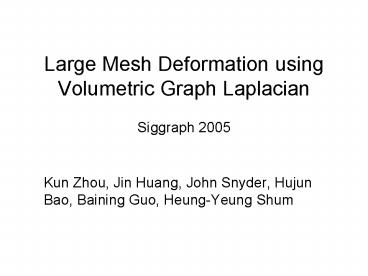Large Mesh Deformation using Volumetric Graph Laplacian PowerPoint PPT Presentation
1 / 20
Title: Large Mesh Deformation using Volumetric Graph Laplacian
1
Large Mesh Deformation using Volumetric Graph
Laplacian
Siggraph 2005
- Kun Zhou, Jin Huang, John Snyder, Hujun Bao,
Baining Guo, Heung-Yeung Shum
2
Mesh deformation
- Useful in computer modeling and animation.
- Recently introduced differential domain methods
are very effective in preserving surface details - There are challenges in large deformation
3
VGL method in this paper
- New method for large mesh deformation
- Based on volumetric graph Laplacian, which
represents volumetric details as the difference
between each point in a 3D volume and the average
of its neighboring points in the graph. - A differential domain method
- Volumetric constraints are represented by
quadratic energy function
4
Differential method for deformation(only applied
on the surface)
- Laplacian deformation of a graph
(Laplacian coordinate)
5
Differential method for deformation(only applied
on the surface)
- Algorithm
- User input deformed vertices qi (i1..m)
- Compute deformed Laplacian coordinate
- Compute the new positions of vertices by solving
the following quadratic minimization problem
(quadratic energy function)
Balance these two objectives
Preserve local details
Constrain the deformed positions of the vertices
qi (i1..m)
6
Disadvantages
- Not good in large deformation
7
VGL algorithm outline
- Step 1 Construct a volumetric graph
- Inside graph (Min)
- prevent large volume change
- Outside graph (Mout)
- prevent local self-intersection
- Step 2 Compute deformed Laplacian coordinates
for the mesh vertices / volumetric graph vertices - Step 3 Perform deformation
- Step 4 Compute new vertex positions
8
Constructing inner graph Min
- (a). Construct an inner shell Min for the mesh M
by offsetting each vertex a distance in the
direction opposite to its normal - (b). Embed Min and M in a body-centered cubic
(BCC) lattice. Remove lattice nodes outside Min. - (c). Build edge connections among M, Min, and
lattice nodes. - (d). Simplify and smooth the vometric graph .
9
Constructing outer graph Mout
- (a). Use the same normal-offset method to
construct Mout just as we create Min - (b). Build connections between M and Mout.
Min
Mout
10
Deforming volumetric graph - using new energy
function
Preserve local details
Constrain the positions of the vertices specified
by the user qi (i1..m)
Preserve volumetric details
G is subgraph of G by removing all the edges
belonging to mesh M
11
Deforming volumetric graph- propagation of local
transform (Curve-based deformation)
- How we get (deformed Laplacian
coordinates) - Recall
- WIRE deformation
- Step1 Select control curve (control points qi
(i1..m)) - Step2 Calculate local transformation for
control points - Compute the deformed coordinates for each point
on the control curve and its 1-ring neighbors on
the mesh - Step3 Propagate the local deformation to the
rest points of the graph via a strength field
f(p)----which is based on the shortest edge path
from p to the curve.
12
Deforming volumetric graph- propagation of local
transform (Curve-based deformation)
- Transformation propagation scheme
- To get smoother result, we compute a weighted
average over all vertices on the control curve
instead of the closest one. - Reciprocal of distance
- Gaussian function
- Final transformation matrix for point p is
Weighted average transformation
13
Deforming volumetric graph- propagation of local
transform (Curve-based deformation)
14
Deforming volumetric graph - weighting scheme
- Recall the graph laplacian
- For the mesh Laplacian , we use cotangent
weights
15
Deforming volumetric graph- weighting scheme
- For the graph Laplacian , we compute weights
by solving a quadratic programming problem
16
Deforming volumetric graph- weighting scheme
17
Deforming volumetric graph- quadratic energy
minimization
- Finally, we minimize the quadratic energy
- by solving
18
The software
- Deformation from 2-D curves
19
The software
20
- Thanks

